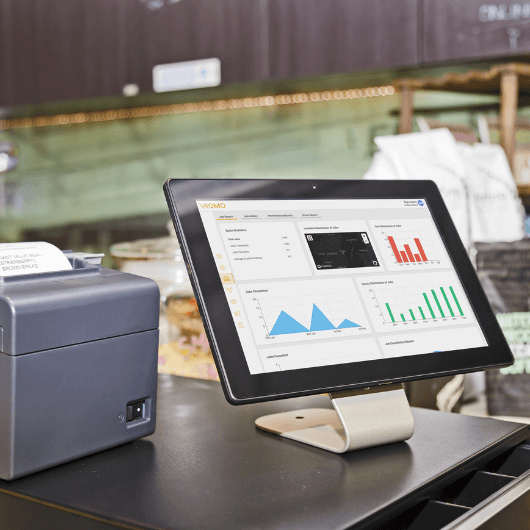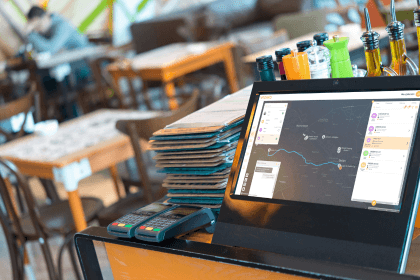
How to make restaurant food delivery profitable
January 4, 2023
Is your restaurant struggling with last-mile delivery problems? Discover practical solutions to overcome common challenges today!

In a world where convenience reigns supreme, the race to perfect the art of the last-mile delivery process has become a top priority for businesses across industries.
Particularly the restaurant industry.
When it comes to pipin’ hot food delivery, you’re not only dealing with customers who expect the entire process to be seamless, you’re dealing with customers who expect the entire process to be seamless while hungry.
It’s a scary thought, right?
Last-mile delivery, the critical link between a food business and its customers, has captured the spotlight as the ultimate battleground for customer satisfaction. And it’s one of the biggest challenges many restaurants come up against today.
As the demand for a comprehensive customer delivery experience and prompt service intensifies, the significance of overcoming last-mile delivery challenges cannot be overstated.
In this guide, we embark on a journey to unravel the concept of last-mile delivery and the complexities it presents for restaurants, their delivery management teams and/or fleet managers.
We’ll also uncover some innovative solutions restaurants can implement to conquer the hurdles that lie in their path.
In the restaurant industry, last-mile delivery refers to the final stage of the delivery process, where food is transported from the restaurant to the customer’s doorstep.
It is the crucial link between the transportation network and the end customer, often representing the most challenging and expensive part of the logistics chain.
The importance of last-mile delivery has grown significantly in recent years.
Here are some of the underlying reasons for such unprecedented growth among restaurants and specialist food delivery companies alike:
Changing customer expectations: Customers now expect fast, reliable, and convenient delivery options resulting in the popularity of same-hour, same-day, or next-day delivery services.
Did you know that 31% of customers expect their food delivery to be at their door within 30 minutes of ordering? It’s no wonder why being a gig economy delivery driver is one of the more difficult careers today.

Urbanization and denser population centers: The world’s population is increasingly concentrated in urban areas, leading to greater demand for last-mile delivery services with a whopping 60% of U.S. consumers claiming to order delivery or takeout once a week.
Expansion of food delivery services: The growth of food delivery platforms and premises such as Marketplace Apps and Dark Kitchens has created a booming market for restaurant delivery services.
Contactless delivery: The pandemic accelerated the need for contactless delivery options resulting in last-mile delivery being an essential service for minimizing physical interactions, and ensuring the safety and well-being of both customers and delivery personnel.
However, as last-mile delivery services continue to evolve alongside customers’ need for convenience, so too do the challenges they present.

While the concept of last-mile delivery may seem like a straightforward process that restaurants can utilize to keep customers happy, it often presents various challenges that can impact customer satisfaction and, unfortunately, the overall costs associated with running a successful delivery business.
However, with the right strategies and tools, such as adopting technology-driven solutions and implementing efficient logistics management, restaurants can transform last-mile delivery into a competitive advantage rather than carry it as a burden.

Customers today have high expectations when it comes to delivery times.
And if they’re hungry, a late delivery situation won’t be pretty.
When a customer is left waiting for an order without warning or updates on when they will receive it, they get upset.
More often than not they reach for the phone where your hard-working team members are on the receiving end, taking on the role of a customer service agent.
Not only do they have to deal with customer complaints, they are taken away from focusing on the customers that are dining in.

Worse again, if the issue isn’t resolved quickly, the customer might leave a bad review online for everyone to see.
As a result, ensuring timely deliveries is crucial to providing a positive customer experience.
By leveraging SMS capabilities, you can adopt a Domino Pizza-style approach to delivery and send your customers a real-time update about their orders.
Remember, an updated customer is a happy customer.
Not only will this prevent angry phone calls to the store and a decrease in online negative reviews, but it’s also going to build an abundance of trust between your brand and customer to improve customer loyalty as well as reduce idle time for delivery drivers.
The ultimate goal of any restaurant business!

Selecting the most efficient delivery driver is a sore point when it comes to last-mile delivery problems. This is particularly true in densely populated areas where it can be difficult to predict what obstacles will present themselves at any given time.
C’mon, we all know how dreadful interstate traffic congestion can be!
Using logical rules that allow you to automatically offer delivery jobs to the most efficient delivery driver is the key to achieving success in this area.
But how can this be done? How can we make a delivery system act like a real-life human dispatcher that would make the right dispatch decision, just quicker?
It all lies in the adoption of technology. After all, as many as 50% of U.S. restaurant operators plan to deploy automation technology in the next 2–3 years to help fill labor gaps.

Restaurant-dedicated fleet management software equips restaurants with the exact tools needed to plan delivery routes based on the real-time tracking of factors such as;
And that’s not even the best part.
By selecting the most valid driver for the occasion every time, restaurants can fulfill up to 15% more orders successfully.
Human error? Never heard of her!

Trying to reduce the cost of delivery is a common challenge in last-mile delivery.
To be honest, it’s one of the major issues that has created a love/hate relationship between restaurants and marketplace players.
Several factors contribute to these increased expenses, including a restaurant being forced to reject orders due to insufficient fulfillment methods and customers requesting refunds due to late deliveries.
But the most costly expense?
Third-party delivery fees.
Third-party delivery services grow from strength to strength due to their unwillingness to share real-time visibility with restaurants.
As a result, restaurants have no control over orders fulfilled by third-party fleets meaning that a driver can fulfill an order without adhering to service or compliance levels.

A huge risk when dealing with hot food delivery.
Subsequently, restaurants are stuck in an unforgiving loop of having to fulfill orders at a huge risk and cost – without any reward.
In more recent years, however, many third-party platforms have partnered with restaurant delivery management software providers to bridge the gap and prevent negative delivery experiences for customers.
From these relationships often comes exclusive delivery rates, which the right delivery management provider can secure for your restaurant.
As a result, restaurants can reduce the total cost of delivery by up to 24% while at the same time ensuring compliance and service levels are being met.
Choosing this route to mitigate delivery costs is as clear-cut a choice as a Papa John’s Pizza slice.

Maintaining food quality and temperature during the last mile of delivery poses a significant threat to restaurants.
The longer the journey from the restaurant to the customer’s doorstep, the greater the risk of food quality deterioration and temperature fluctuations.
Is there anything worse than a soggy pizza that looks like something from the Chuck E Cheese conspiracy? Hell no.
However, there are plenty of effective and easy solutions restaurants can implement to overcome this challenge.

By prioritizing quality packaging, quicker delivery times, and technological tools, restaurants can deliver food that meets or even exceeds customer expectations, ensuring an exceptional dining experience right at their doorstep.

The bottom line on how and why a concerted effort should be made to navigate last-mile delivery problems is that they pose significant challenges for many businesses – both logistics companies and food delivery service providers alike.
However, no last-mile delivery risk is as great as the hot food delivery journey restaurants must undergo.
From dealing with hangry customers to maintaining food quality and temperatures, if you’re working in the restaurant industry, as the great Usher would put it, you got it bad.
Addressing these challenges and ensuring efficient delivery is of utmost importance to meet customer expectations, reduce operational costs, and improve overall customer satisfaction.
Adopting technology solutions like delivery driver apps and fleet management software can greatly assist in overcoming these challenges and optimizing last-mile delivery.
Remember, this is just the tip of the iceberg when it comes to last-mile delivery problems. If any of these other 8 red flags of delivery resonate with you and your restaurant, maybe it’s time to take matters into your own hands.
Book a call with our team of experts to get a free audit of your food delivery channel and a walkthrough of how our solution can solve these problems faster than you can decide not to cook tonight!
Deliver more for your customers with reliable food delivery management software that automates dispatch, improves customer experience and increases profitability with ease.

January 4, 2023

September 4, 2022

May 1, 2023